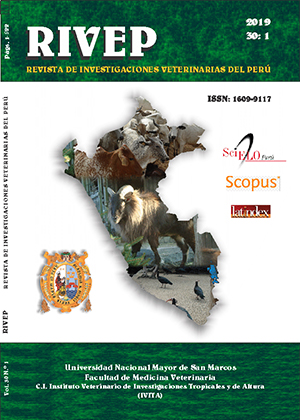Relationship between behavioral indicators of animal welfare and physicochemical properties of beef
DOI:
https://doi.org/10.15381/rivep.v30i1.15674Keywords:
animal welfare; behavioral indicators; traditional slaughter; meat quality; correlations; lineal regressionAbstract
The study was conducted in the slaughterhouse of Chachapoyas, Amazonas, Peru, between January and October 2017, with the aim to determine the correlation between the behavioral indicators of animal welfare during the slaughter and the physicochemical properties of the beef. Ninety-nine bovines were classified by sex, age and breed group. The slaughter stages (conduction, subjection, shoot down and bleeding) were related with the behavioral indicators of animal welfare (blows, tail twists, operator shouts, slips, falls, vocalizations, attempts to incorporate, punctures to pull down, total punctures, times of each stage and time between pull down and bleeding). The physicochemical properties in the Longissimus dorsi muscle between the fifth and seventh ribs were evaluated. The results indicated that shoot down was the most critical stage of the slaughter due to the greater occurrence of indicator events. There were no differences between pH0, pH1 and pH24 between groups (p<0.05); however, there were differences in drip losses according to breed group. The number of blows, tail twists, operator shouts, slips, falls, punctures to the pull down, vocalizations, attempts of incorporation and total punctures were related to the time of each stage of the slaughter (p<0.05). On the other hand, only pH0 was related to pH1 (R = 0.44, R2 = 0.19), where the regression equations had correlation coefficients and determination of medium to low (p<0.05). In conclusion, there is a significant correlation of medium to low between the behavioral indicators and the physicochemical properties of the beef, which can be predicted by such behavioral indicators by means of regression equations with correlation coefficients and determination of similar value.
Downloads
Downloads
Published
Issue
Section
License
Copyright (c) 2019 Hurley Quispe, Ilse Cayo-Colca, José Saucedo

This work is licensed under a Creative Commons Attribution-NonCommercial-ShareAlike 4.0 International License.
AUTHORS RETAIN THEIR RIGHTS:
a. Authors retain their trade mark rights and patent, and also on any process or procedure described in the article.
b. Authors retain their right to share, copy, distribute, perform and publicly communicate their article (eg, to place their article in an institutional repository or publish it in a book), with an acknowledgment of its initial publication in the Revista de Investigaciones Veterinarias del Perú (RIVEP).
c. Authors retain theirs right to make a subsequent publication of their work, to use the article or any part thereof (eg a compilation of his papers, lecture notes, thesis, or a book), always indicating the source of publication (the originator of the work, journal, volume, number and date).










